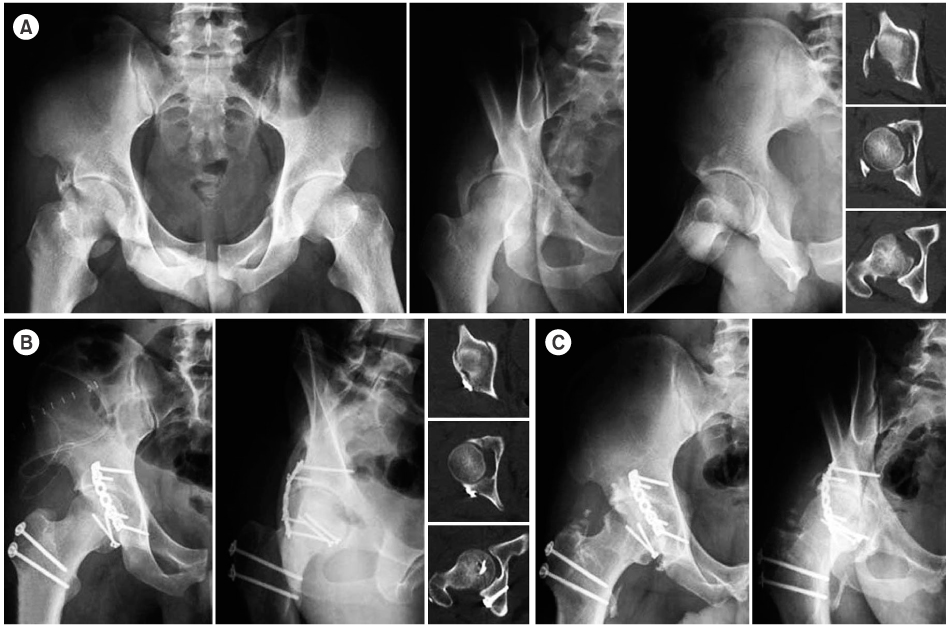J Korean Fract Soc.
2007 Apr;20(2):123-128. 10.12671/jkfs.2007.20.2.123.
Surgical Treatment of Posterior Wall Fractures of the Acetabulum
- Affiliations
-
- 1Department of Orthopedic Surgery, Daegu Fatima Hospital, Daegu, Korea. fatimaos@unitel.co.kr
- KMID: 2295568
- DOI: http://doi.org/10.12671/jkfs.2007.20.2.123
Abstract
- PURPOSE
To evaluate the results of surgical treatment of posterior wall fractures of the acetabulum and to determine the factors affecting the results.
MATERIALS AND METHODS
Thirty-one posterior wall fractures were reviewed; 7 type A1-1, 19 type A1-2 and 5 type A1-3 by AO classification. Postoperatively, the accuracy of the reduction was evaluated. At the final follow-up, clinical and radiographic results were evaluated with medical records and radiographs. The factors affecting the results were determined.
RESULTS
The reduction was graded as anatomical in 22 patients, imperfect in seven and poor in two. The clinical result was excellent in 21 hips, good in six, fair in three and poor in one. The quality of the reduction was strongly associated with the clinical result. The radiographic result was excellent in 22 hips, good in five, fair in two and poor in two. The clinical result was related closely to the radiographic result. Complications were osteoarthritis in three patients, osteonecrosis of the femoral head in one, heterotopic ossification in one, penetration of a screw into the joint in one and iatrogenic sciatic nerve injury in one. The factors affecting the clinical results were fracture patterns, the surgeon's experience, the accuracy of the reduction and late complications.
CONCLUSION
In this present series of posterior wall fractures, as their prognosis depends on the severity of the injury and the accuracy of the reduction, satisfactory result can be obtained by anatomical reduction with thorough preoperative planning and the surgeon's experience.
MeSH Terms
Figure
Reference
-
1. Baumgaertner MR. Fractures of the posterior wall of the acetabulum. J Am Acad Orthop Surg. 1999; 7:54–65.
Article2. Brooker AF, Bowerman JW, Robinson RA, Riley LH Jr. Ectopic ossification following total hip replacement. Incidence and a method of classification. J Bone Joint Surg Am. 1973; 55:1629–1632.3. Calkins MS, Zych G, Latta L, Borja FJ, Mnaymneh W. Computed tomography evaluation of stability in posterior fracture dislocation of the hip. Clin Orthop Relat Res. 1988; 227:152–163.
Article4. Epstein HC. Posterior fracture-dislocations of the hip; longterm follow-up. J Bone Joint Surg Am. 1974; 56:1103–1127.5. Kebaish A, Roy A, Rennie W. Displaced acetabular fractures: long-term follow-up. J Trauma. 1991; 31:1539–1542.6. Keith JE Jr, Brashear HR Jr, Guiford WB. Stability of posterior fracture-dislocations of the hip. Quantitative assessment using computed tomography. J Bone Joint Surg Am. 1988; 70:711–714.
Article7. Letournel E. Acetabulum fractures: classification and management. Clin Orthop Relat Res. 1980; 151:81–106.
Article8. Letournel E, Judet R. Fractures of the acetabulum. 2nd ed. New York: Springer-Verlag;1993. p. 535–563.9. Matta JM. Fracture of the acetabulum: accuracy of reduction and clinical results in patients managed operatively within three weeks after the injury. J Bone Joint Surg Am. 1996; 78:1632–1645.
Article10. Matta JM, Merritt PO. Displaced acetabular fractures. Clin Orthop Relat Res. 1988; 230:83–97.
Article11. Middlebrooks ES, Sims SH, Kellam JF, Bosse MJ. Incidence of sciatic nerve injury in operatively treated acetabular fractures without somatosensory evoked potential monitoring. J Orthop Trauma. 1997; 11:327–329.
Article12. Min BW, Kang CS, Pyun YS, Song KS, Kang CH, Lee SH. Surgical treatment for posterior fracture-dislocations of the hip with fracture of acetabulum. J Korean Soc Fract. 1994; 7:530–537.
Article13. Moed BR, Carr SE, Watson JT. Open reduction and internal fixation of posterior wall fractures of the acetabulum. Clin Orthop Relat Res. 2000; 377:57–67.
Article14. Olson SA, Bay BK, Pollak AN, Sharkey NA, Lee T. The effect of variable size posterior wall acetabular fractures on contact characteristics of the hip joint. J Orthop Trauma. 1996; 10:395–402.
Article15. Pantazopoulos T, Nicolopoulos CS, Babis GC, Theodoropoulos T. Surgical treatment of acetabular posterior wall fractures. Injury. 1993; 24:319–323.
Article16. Saterbak AM, Marsh JL, Brandser E, Nepola JV, Turbett T. Outcome of surgically treated posterior wall acetabular fractures. Orthop Trans. 1997; 21:627.17. Siebenrock KA, Gautier E, Ziran BH, Ganz R. Trochanteric flip osteotomy for cranial extension and muscle protection in acetabular fracture fixation using a Kocher-Langenbeck approach. J Orthop Trauma. 1998; 12:387–391.
Article18. Tile M, Helfet DL, Kellam JF. Fractures of the pelvis and acetabulum. 3rd ed. Philadelphia: Lippincott Williams & Wilkins;2003. p. 427–475. p. 547–558.19. Vailas JC, Hurwitz S, Wiesel SW. Posterior acetabular fracture-dislocations: fragment size, joint capsule, and stability. J Trauma. 1989; 29:1494–1496.20. Won CH, Kim YM, Park KJ, Jeong KI, Lee SN. Results of treatment for acetabular fracture involving posterior wall. J Korean Soc Fract. 1999; 12:754–760.
Article21. Yang KH, Han DY, Park SJ, Jung JM. Anatomical results according to fracture pattern after surgical treatment of acetabular fractures. J Korean Soc Fract. 2000; 13:754–760.
Article
- Full Text Links
- Actions
-
Cited
- CITED
-
- Close
- Share
- Similar articles
-
- Surgical Treatment of the Posterior wall Fracture of Acetabulum with Posterior Hip Dislocation
- Results of Treatment for Acetabular Fracture involving Posterior Wall
- Surgical Treatment of Acetabular Posterior Wall Fracture with Hip Arthroscopy: A Case Report
- Anatomical Results According to Fracture Pattern after Surgical Treatment of Acetabular Fractures
- Surgical Treatment of Displaced Acetabular Fractures



